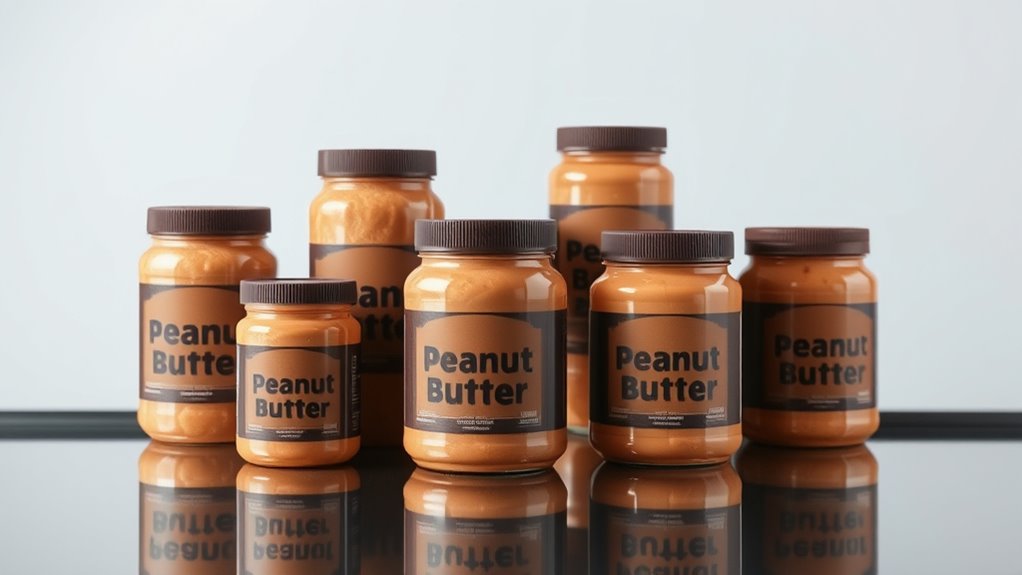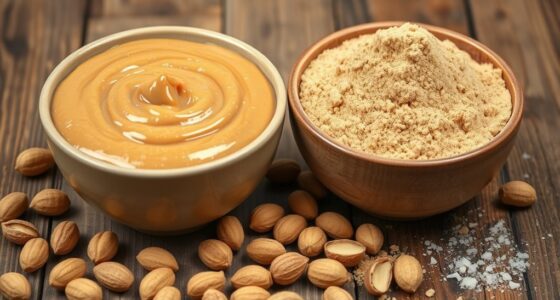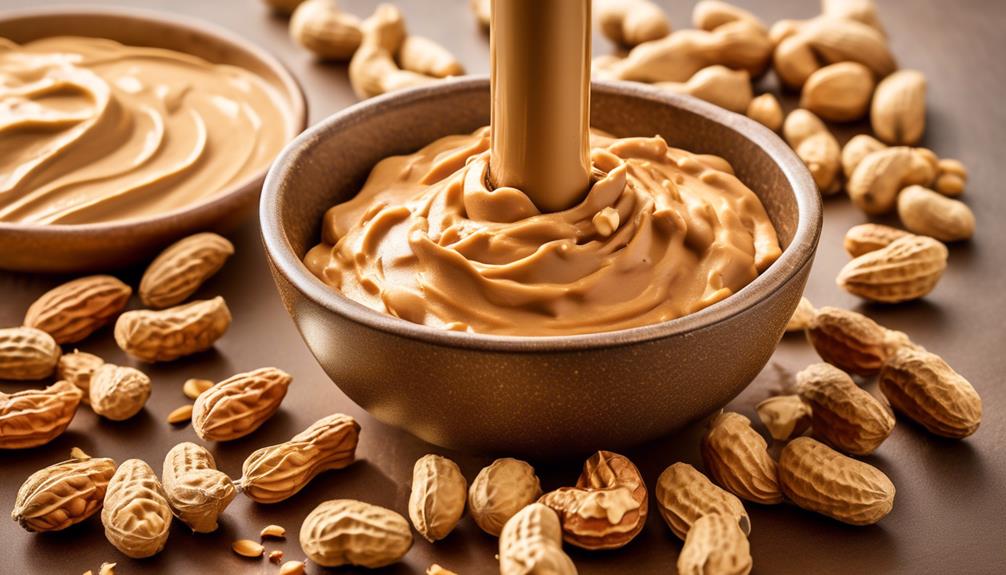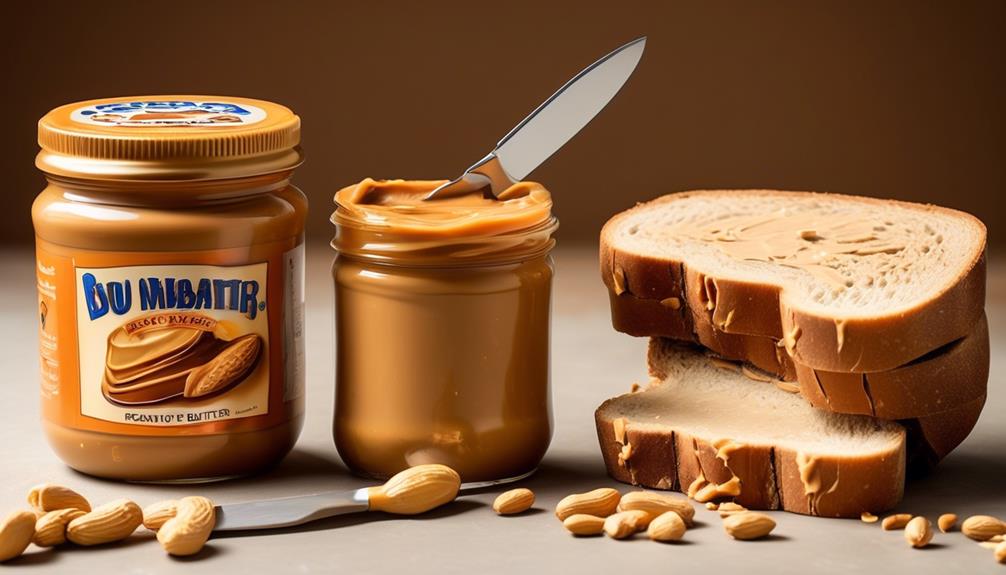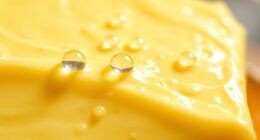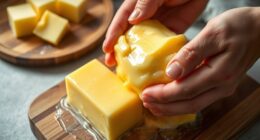Shelf-stable peanut butter keeps its quality and safety by controlling water activity, which limits microbial growth and spoilage. By using formulation techniques like adding salt or fiber and employing advanced packaging, manufacturers reduce water activity to guarantee longer shelf life without refrigeration. Maintaining low water activity also helps preserve flavor, texture, and nutrients over time. To discover more about how water activity influences shelf-stable peanut butter, explore further insights below.
Key Takeaways
- Water activity controls microbial growth, ensuring shelf stability and safety of peanut butter products.
- Low water activity preserves texture, flavor, and nutrients over extended storage periods.
- Proper packaging (vacuum or modified atmosphere) prevents moisture ingress, maintaining low water activity.
- Accurate measurement of water activity helps optimize formulation and shelf-life management.
- Environmental factors like temperature fluctuations can increase water activity, risking spoilage and quality degradation.
Understanding Water Activity and Its Role in Food Safety
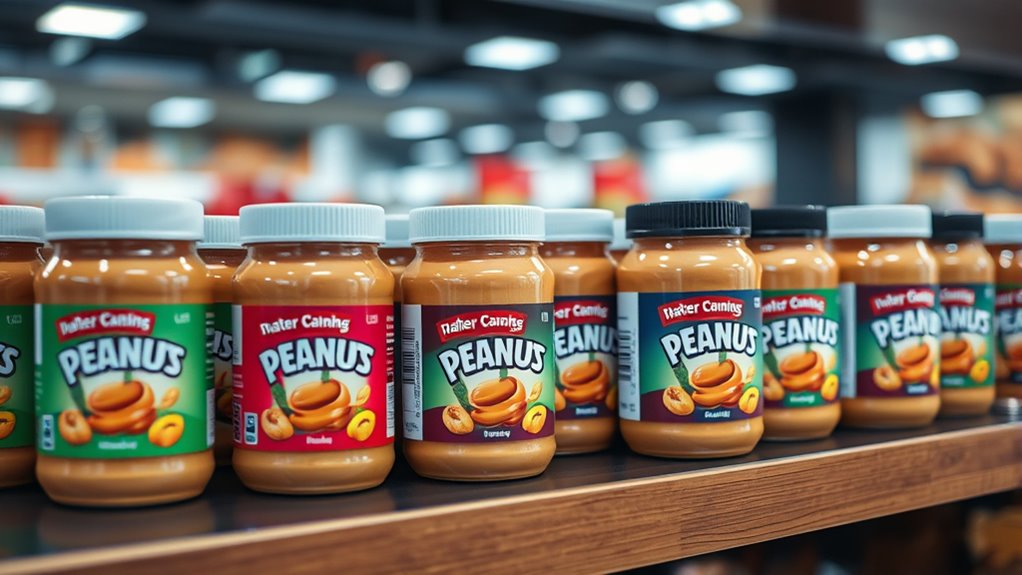
Water activity (a_w) measures the availability of free water in a food product, which directly influences its safety and shelf stability. In peanut butter, controlling a_w helps preserve nutritional content by preventing microbial growth and spoilage. Packaging innovations play a vital role here; advanced materials and methods reduce moisture migration, maintaining ideal water activity levels. When a_w is carefully managed, your peanut butter remains fresh longer without sacrificing nutrients like healthy fats and proteins. These innovations not only extend shelf life but also guarantee that the product stays safe to consume over time. Understanding how water activity impacts safety allows you to appreciate the significance of these packaging solutions in preserving both the quality and nutritional value of shelf-stable peanut butter. Moreover, integrating data-driven strategies in packaging design can optimize water activity control, ensuring consistent product safety and quality.
The Science Behind Shelf Stability in Peanut Butter

You might not realize it, but controlling water activity levels is key to keeping peanut butter safe and shelf-stable. When water activity is low, harmful microbes can’t grow, ensuring your peanut butter stays fresh longer. By understanding this balance, manufacturers can prevent spoilage and extend shelf life effectively. Vetted formulations play a crucial role in maintaining optimal water activity levels for shelf stability.
Water Activity Levels
Understanding water activity levels is essential to grasping how peanut butter remains shelf-stable. Water activity measures the availability of free moisture that influences microbial growth, nutrient retention, and flavor stability. Lower water activity inhibits bacteria, molds, and yeasts, preventing spoilage without destroying nutrients. In shelf-stable peanut butter, water activity is carefully controlled to maintain quality over time. Keeping water activity low helps preserve nutrient content and ensures flavors stay fresh and stable. If water activity is too high, the product becomes vulnerable to spoilage and quality degradation. By managing water activity, manufacturers create peanut butter that stays safe, flavorful, and nutrient-rich for extended periods. This precise control is key to producing shelf-stable peanut butter with optimal shelf life and consistent quality. Water activity levels are carefully monitored during production to ensure the product remains within the safe range.
Microbial Growth Control
Controlling microbial growth is vital to keeping peanut butter safe and shelf-stable. By maintaining low water activity levels, manufacturers inhibit bacteria, molds, and yeasts that could spoil the product. Packaging innovations play a key role, as modern containers prevent moisture ingress and contamination, further reducing microbial risks. These innovations also help preserve flavor enhancement, guaranteeing the peanut butter retains its original taste over time. Additionally, effective packaging can extend shelf life by creating a barrier against oxygen and light, which can promote microbial growth. Ongoing automation in manufacturing supports consistent quality control and efficiency. You benefit from these technologies through a product that stays fresh longer, maintains its quality, and offers consistent flavor. Overall, combining water activity control with advanced packaging ensures your shelf-stable peanut butter remains safe, flavorful, and enjoyable.
How Water Activity Affects Microbial Growth and Spoilage
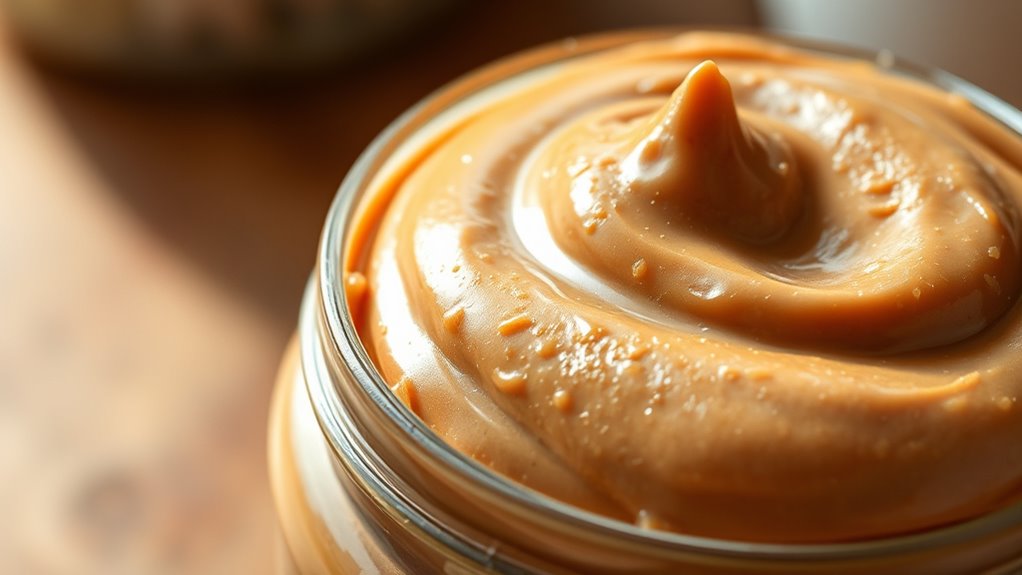
Water activity (a_w) plays a crucial role in microbial growth and spoilage of food products like peanut butter. When a_w is high, microbes such as bacteria, yeasts, and molds thrive, leading to spoilage and potential safety issues. Controlling water activity helps prevent moisture migration within the product, which can cause changes in texture and quality. Low a_w levels inhibit microbial activity, extending shelf life and ensuring safety. Maintaining ideal water activity also preserves the desired texture of peanut butter, preventing it from becoming overly sticky or dry. By managing water activity effectively, you reduce the risk of microbial contamination while keeping the product’s texture consistent and appealing over time. Proper water activity levels are essential for preventing nutrient loss and maintaining the product’s overall quality. This balance is essential for creating shelf-stable peanut butter that stays safe and high quality.
Formulation Strategies to Achieve Low Water Activity
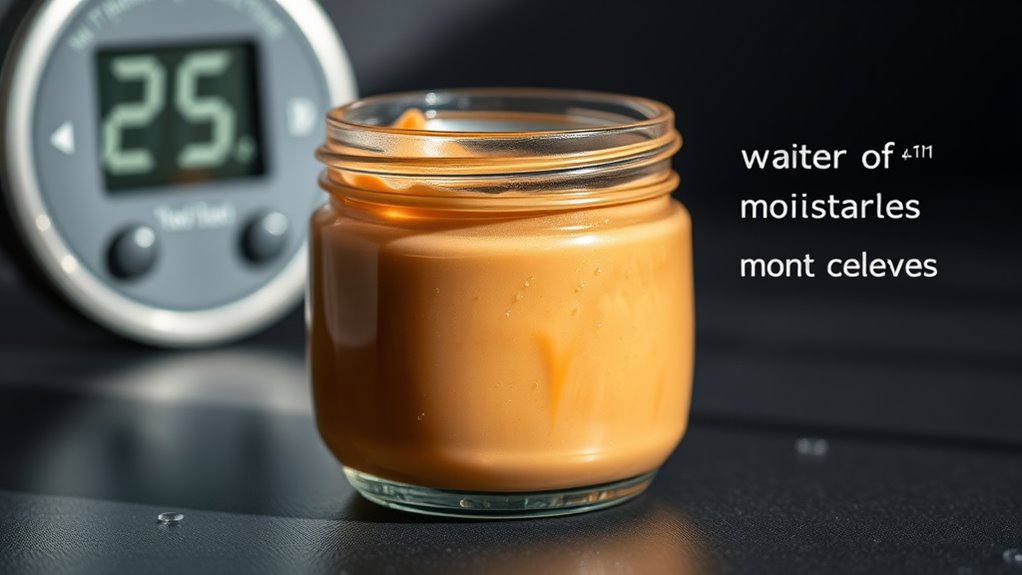
To achieve low water activity in shelf-stable peanut butter, formulators often incorporate ingredients that bind moisture and reduce free water available for microbial growth. Humectants like salt, sugar, or certain fiber sources interact with water molecules, decreasing their mobility and creating a less hospitable environment for spoilage organisms. Ingredient interactions are essential; selecting compatible components ensures stability and maintains product quality. Packaging considerations also play a key role; using moisture-proof, airtight containers prevents water ingress from the environment, helping preserve the low water activity. Additionally, proper sealing and inert atmospheres can minimize moisture transfer, further stabilizing the product. Water activity control is crucial in preventing microbial proliferation and extending shelf life. Combining these formulation strategies with suitable packaging effectively prolongs shelf life and ensures safety without compromising taste or texture.
Measuring Water Activity in Peanut Butter Products
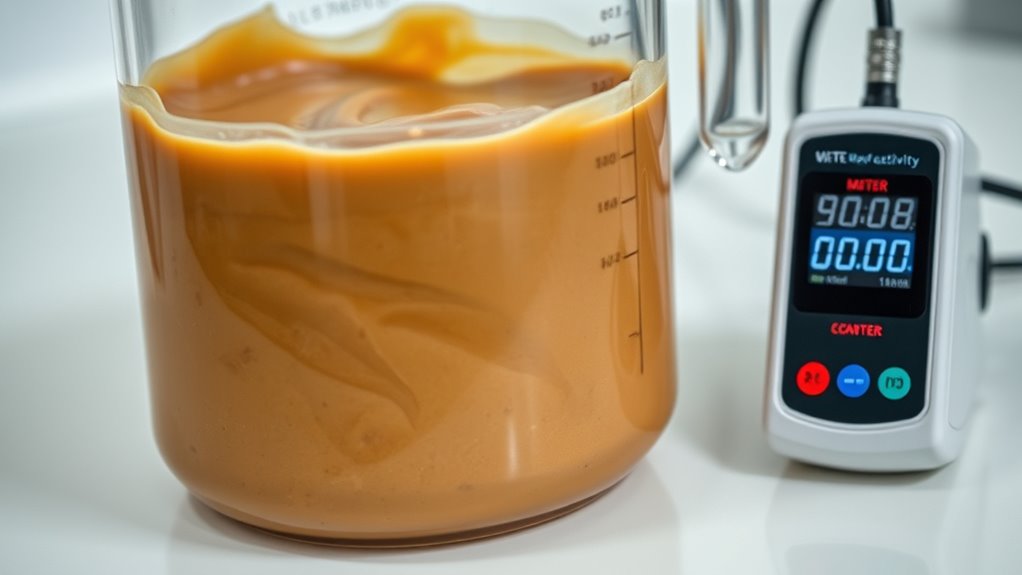
Accurately measuring water activity in peanut butter products is essential for evaluating their stability and safety. Precise water activity readings help you determine if the product can inhibit microbial growth and maintain quality over time. Using reliable instruments, like dew point or chilled mirror hygrometers, allows you to obtain consistent results. These measurements directly influence flavor enhancement strategies, guaranteeing the peanut butter retains ideal taste and texture. They also inform packaging innovation, as selecting appropriate barriers depends on controlling moisture migration. Proper water activity measurement ensures your product remains shelf-stable, prevents spoilage, and meets safety standards. By regularly monitoring water activity, you can fine-tune formulations and packaging to extend shelf life without compromising flavor or quality. Additionally, understanding the role of color accuracy in product appearance can help maintain consumer appeal and product consistency.
Comparing Shelf-Stable and Traditional Peanut Butter

Shelf-stable and traditional peanut butter differ mainly in water activity levels, which affect their shelf life and safety. You’ll notice that shelf-stable versions often have a different texture because of preservation methods. Understanding these points helps you choose the right peanut butter for your needs. Additionally, the water activity level in each type influences microbial growth and overall stability.
Water Activity Levels
Have you ever wondered why shelf-stable peanut butter lasts so long without refrigeration? It all comes down to water activity levels. Shelf-stable varieties are formulated with low water activity, which limits microbial growth and spoilage. This control helps preserve nutrient retention and flavor stability over time. Traditional peanut butter typically has higher water activity, making it more susceptible to moisture absorption and microbial activity, which can degrade quality. By reducing water activity, shelf-stable options maintain their nutritional value and fresh flavor longer without refrigeration. This careful balance ensures your peanut butter stays safe, tasty, and nutritious, even after months on the shelf. Understanding water activity levels helps you choose products that offer better longevity and stability without compromising quality.
Preservation and Texture
While traditional peanut butter often develops a thick, oily separation over time, shelf-stable varieties maintain a more consistent texture thanks to their formulation. This stability enhances flavor preservation and prevents spoilage. Packaging innovations, like vacuum-sealed or modified atmosphere packaging, further support preservation and help retain *ideal* texture. These advancements also reduce the need for added preservatives, allowing natural flavors to shine. The following table highlights key differences:
| Aspect | Traditional Peanut Butter | Shelf-Stable Peanut Butter |
|---|---|---|
| Texture | Oily separation, thick | Uniform, smooth |
| Flavor Enhancement | Often muted over time | Consistent, fresh taste |
| Preservation Method | Natural oils, preservatives | Packaging innovations |
| Water Activity | Higher, prone to spoilage | Controlled, stable |
| Packaging | Jars, open exposure | Vacuum, sealed |
This comparison shows how preservation techniques directly influence texture and flavor retention.
Challenges in Maintaining Quality Over Time
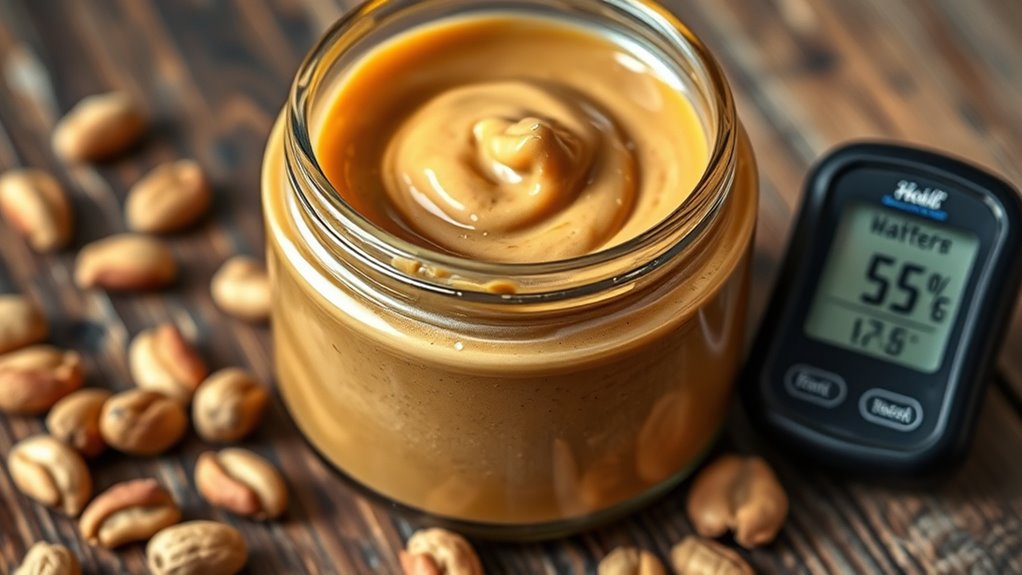
Maintaining the quality of shelf-stable peanut butter over time presents several challenges that can affect both its texture and flavor. Fluctuations in storage temperature can cause oils to separate or become rancid, diminishing freshness. If the temperature is too high or varies considerably, it accelerates spoilage and alters the product’s consistency. Packaging materials play a vital role in preserving quality; inadequate or permeable packaging allows moisture and oxygen to enter, which can lead to microbial growth or oxidation. Choosing proper packaging that provides an effective barrier helps prevent these issues. Additionally, improper storage conditions can cause the peanut butter to develop off-flavors or undesirable texture changes. To maintain ideal quality, you need to control storage temperature and select packaging materials that safeguard against environmental influences over time. Moreover, understanding the water activity levels in the product is essential, as it directly impacts microbial stability and shelf life.
Future Trends in Shelf-Stable Nut Butters

Advances in food technology are shaping the future of shelf-stable nut butters, making them more convenient, nutritious, and sustainable. You can expect innovative packaging solutions that extend shelf life while reducing environmental impact, such as biodegradable containers or resealable pouches. These innovations cater to consumer preferences for eco-friendly, easy-to-use products. Additionally, manufacturers are focusing on clean-label ingredients and functional enhancements, like added superfoods or probiotics, to meet health-conscious demands. Transparency about water activity levels and preservation methods will become more prevalent, helping you make informed choices. As consumer preferences shift toward sustainable, minimally processed foods, future nut butters will likely prioritize minimal additives and eco-friendly packaging, aligning with your desire for healthier, more responsible products.
Frequently Asked Questions
How Does Packaging Influence Water Activity in Shelf-Stable Peanut Butter?
Packaging plays a vital role in controlling water activity in shelf-stable peanut butter. Using packaging materials with strong moisture barriers prevents moisture transfer, keeping the product dry and stable. You should choose packaging that minimizes water vapor permeability, ensuring the peanut butter stays shelf-stable longer. By selecting appropriate moisture barriers, you help maintain low water activity, which inhibits microbial growth and preserves quality.
Can Added Preservatives Affect Water Activity Levels?
You might wonder if added preservatives influence water activity levels. Preservative interactions can affect water activity regulation by binding moisture or altering the product’s environment. Some preservatives help control water activity, reducing microbial growth, while others may have minimal impact. By understanding these interactions, you can better manage shelf stability and ensure your peanut butter remains safe and fresh over time.
What Are the Environmental Impacts of Producing Shelf-Stable Peanut Butter?
You might think making shelf-stable peanut butter is simple, but it’s not. The environmental footprint involves energy-intensive processes and packaging waste, ironically increasing sustainability concerns. However, choosing sustainable sourcing can reduce deforestation and water use. By supporting eco-friendly practices, you help lessen environmental impacts. Your choices matter—opt for brands committed to reducing their ecological footprint, making your snack both delicious and environmentally responsible.
How Do Consumer Preferences Change With Water Activity Modifications?
When water activity levels change, your texture preferences and flavor perception also shift. You might notice a firmer, drier peanut butter that feels less creamy, or a more moist, spreadable one that enhances flavor. These modifications influence how much you enjoy the product, as your taste buds and tactile experience adapt. Ultimately, lower water activity can make the peanut butter seem less fresh, impacting your overall satisfaction and preference.
Are There Natural Ways to Reduce Water Activity in Peanut Butter?
Think of reducing water activity in peanut butter as guiding a boat through calm waters. You can naturally steer it by using natural drying, which gently pulls moisture away, or adding salt, like a sailor using a compass to find balance. These methods help lower water activity without artificial additives, making your peanut butter more shelf-stable. So, yes, natural drying and salt addition are effective, safe ways to achieve this goal.
Conclusion
By understanding water activity, you can master the art of creating shelf-stable peanut butter that defies time and spoilage. With careful formulation and precise measurement, you’ll open a world where microbial threats are banished, and quality endures like a legend. Embrace these insights, and you’ll craft products that stand the test of time—truly a feat of engineering that could outlast even the oldest legends. Your journey to perfect shelf stability starts now.
